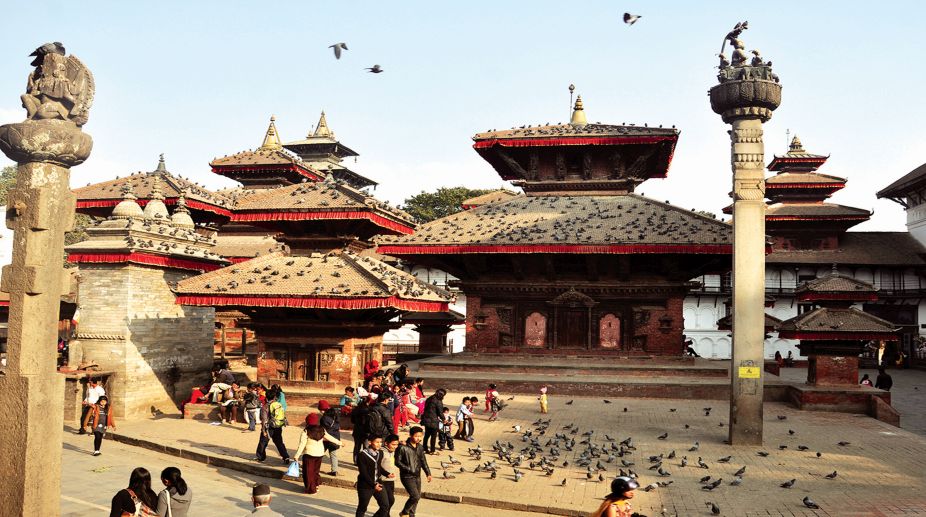The Valley of Kathmandu is one of Asia’s loveliest sites. It is surrounded by tall hills and bounded on the north by the Himalayas. Nowhere in the world can one find the same concentration of art, culture and tradition that exists in the Kathmandu Valley.
The Hanuman Dhoka Durbar Square is undoubtedly the most fascinating place in Kathmandu. During our visit it was our favourite haunt. Ensconced on the wooden steps of the immense, open-sided Kashtamandap temple, I had a choice vantage point from which to view the colourful tapestry of diverse, yet unhurried activity all around. I could ponder on the mystic splendour of the palaces, sacred Pagoda-like temples, venerable shrines, and multiform statuary of gods, kings and animals that fill the square.
Advertisement
The large square in front, known as Masan Chowk, houses an unusual temple of Shiva and Parvati, on its left side. The rectangular temple is unique in form and has carvings of earlier periods. Overlooking the chowk in the upper window of the temple are images of Shiva and Parvati. A pair of stone lions guards its entrance gate.
A little further is the Jagannath temple, just beyond which looms the hulking, terrifying image of Kal Bhairab, the god of justice, and the most frightening figure in Nepalese mythology. Kal Bhairab, with tongue protruding, wearing a crown of human skulls, threatens a gamut of punishment with his multiple arm-bearing hands but also attracts the attention of most photographers.
The main Durbar, the stately, white-shuttered palace of yesteryear, now a creaky historical museum, dominates the part of the square known as Hanuman Dhoka. Just outside the ornamental gateway to the Hanuman Dhoka, panoply of palace buildings, elaborate courtyards, stands Kathmandu’s most beloved statue — Hanuman. The New Palace building, which is a little far from there, does not attract too many tourists these days.
Access to the Mul Chowk and the impressive Teleju Mandir is restricted to members of the palace, save for one day during Dasain (Dussera) festival.
A totally different kind of deity dwells in a majestic old wooden temple on the opposite side of the square. Adjacent to that temple is a three-storied building with a traditional brick façade. It is the dwelling of the Kumari, the Living Goddess, who is a young virgin of the Shakya Caste, considered to be an incarnation of Teleju Bhawani.
The Valley of Kathmandu is picturesque with rolling fields that stretch up to the surrounding hills. Just beyond the city limits is the Swayambhunath Stupa, a white hemispherical dome with a pair of intense eyes peering in each of the four directions and a golden crown that catches the first burst of sunlight and sprays it across the fog. A steep climb leads to the summit of a 75-metre-high hill.
Around the great stupa are hundreds of smaller stupas, a large dorje (or Bajra), a symbolic lightening bolt, and rows of prayer wheels. The other great stupa in the Kathmandu Valley, and the largest in Nepal, is the Bodhnath Stupa, worshipped only by Tibetan Buddhists. Encircling the stupa is a Tibetan township, whose many small shops are a delight to those in search of souvenirs.
The western bank of the Bagmati River boasts of the impressive Pashupatinath (Lord Shiva) temple complex that is entered through huge doors sheathed in ornate silver, and a gilded image of Nandi, the bovine steed of Lord Shiva. There are many smaller temples inside the complex and gilded statues of kings and queens of the Malla Dynasty. A splendid overall view of its roofed shrines can be enjoyed from the sloping bank on the other side of the Bagmati.
On the northern outskirt of the city is another important shrine of Bodhinilkanta. It is another representation of Lord Vishnu, reputedly dating from the fifth century. The image depicts Vishnu reclining on a bed of snakes, fast asleep as a result of having drunk a draught of poison. The image is carved out of a single black stone and is set in a pool, thus giving it the appearance of floating.
At the north end of the city of Kathmandu is Thamel, once the haven for hippies, and now a base for backpacking foreigners. Here, besides trekking gear shops, the hippy legacy can be seen in colourfully named restaurants, shops and lodges. There are the pie shops, print shops, second hand book shops with names like “The Tamang Tantric” and “High”. There are colourful, flower-decked rickshaws and lots of interesting brick-a-brac. The little lanes of Thamel make a pleasurable experience to walk around in or just for people watching.
But all these do not mean Kathmandu is all sightseeing and no fun. It has a great shopping scene where you could buy almost anything from cheap Chinese gadgets to all kind of upmarket goodies. It has a number of discos that are quite affordable, good restaurants and above all at least five glitzy casinos.
All the major casinos are part of the leading five-star hotels, which keep the tariff low to attract guests. And, even if you just visit any casino and play; you can enjoy its lavish on-the-house buffet. So play hard and enjoy the hospitality of the house at the same time.











